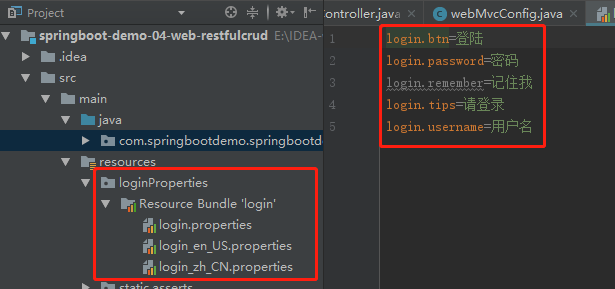SpringBoot2.0(4)wep开发(2)-----实现增删改查+登陆拦截+页面国际化功能
(1)默认登陆首页
首先要想访问首页,两种实现方式
a.使用@Controller的方式,这也是最简单的方式实现页面访问
@Controller
public class loginController {
//
// @GetMapping(value = {"/"})
// @PutMapping
// @DeleteMapping
//@RequestMapping(value = "/user/login",method = RequestMethod.POST)
@RequestMapping(value = {"/"})
public String login(){
return "login";
}
}
b.写配置类,其实就是通过
addViewControllers添加跳转映射
@Configuration
public class webMvcConfig implements WebMvcConfigurer {
@Override
public void addViewControllers(ViewControllerRegistry registry) {
registry.addViewController("/").setViewName("login");
registry.addViewController("/main.html").setViewName("dashboard");
}
}
(2)登陆页面的国际化功能
具体实现
a、
编写国际化配置文件,抽取页面需要显示的国际化消息
因为
SpringBoot
自动配置好了管理国际化资源文件的组件,下面看一下源码了解下具体是怎么配置的
@ConfigurationProperties(prefix = "spring.messages")
public class MessageSourceAutoConfiguration {
/**
* Comma‐separated list of basenames (essentially a fully‐qualified classpath
* location), each following the ResourceBundle convention with relaxed support for
* slash based locations. If it doesn't contain a package qualifier (such as
* "org.mypackage"), it will be resolved from the classpath root.
*/
private String basename = "messages";
//我们的配置文件可以直接放在类路径下叫messages.properties;
@Bean
public MessageSource messageSource() {
ResourceBundleMessageSource messageSource = new ResourceBundleMessageSource();
if (StringUtils.hasText(this.basename)) {
//设置国际化资源文件的基础名(去掉语言国家代码的)
messageSource.setBasenames(StringUtils.commaDelimitedListToStringArray(
StringUtils.trimAllWhitespace(this.basename)));
}
if (this.encoding != null) {
messageSource.setDefaultEncoding(this.encoding.name());
}
messageSource.setFallbackToSystemLocale(this.fallbackToSystemLocale);
messageSource.setCacheSeconds(this.cacheSeconds);
messageSource.setAlwaysUseMessageFormat(this.alwaysUseMessageFormat);
return messageSource;
}
b、 去前端页面抽取国际化的值,SpringBoot已经添加了Thymeleaf解析,
<!DOCTYPE html>
<html lang="en" xmlns:th="http://www.thymeleaf.org">
<head>
<meta http-equiv="Content-Type" content="text/html; charset=UTF-8">
<meta name="viewport" content="width=device-width, initial-scale=1, shrink-to-fit=no">
<meta name="description" content="">
<meta name="author" content="">
<title>Signin Template for Bootstrap</title>
<!-- Bootstrap core CSS -->
<!--把webjars的bootstrap框架引进来解析Thymeleaf模板-->
<link href="asserts/css/bootstrap.min.css" th:href="@{/webjars/bootstrap/4.1.0/css/bootstrap.css}" rel="stylesheet">
<!-- Custom styles for this template -->
<!--使用Thymeleaf模板引擎把自定义的界面样式引进来-->
<link href="asserts/css/signin.css" th:href="@{asserts/css/signin.css}" rel="stylesheet">
</head>
<body class="text-center">
<form class="form-signin" action="dashboard.html" th:action="@{/user/login}" method="post">
<img class="mb-4" src="asserts/img/bootstrap-solid.svg" th:src="@{asserts/img/bootstrap-solid.svg}" alt="" width="72" height="72">
<h1 class="h3 mb-3 font-weight-normal" th:text="#{login.tips}">Please sign in</h1>
<p style="color: red;" th:text="${msg}" th:if="${not #strings.isEmpty(msg)}"></p>
<label class="sr-only" th:text="#{login.username}">Username</label>
<!--作为可与服务器交互数据的HTML元素的服务器端的标示,比如input、select、textarea、
和button等。我们可以在服务器端根据其Name通过Request.Params取得元素提交的值。-->
<input type="text" name="username" class="form-control" placeholder="Username" th:placeholder="#{login.username}" required="" autofocus="">
<label class="sr-only" th:text="#{login.password}">Password</label>
<input type="password" name="password" class="form-control" placeholder="Password" th:placeholder="#{login.password}" required="">
<div class="checkbox mb-3">
<label>
<input type="checkbox" value="remember-me" > [[#{login.remember}]]
</label>
</div>
<button class="btn btn-lg btn-primary btn-block" type="submit" th:text="#{login.btn}">Sign in</button>
<p class="mt-5 mb-3 text-muted">© 2017-2018</p>
<a class="btn btn-sm" th:href="@{/login.html(l='zh_CN')}">中文</a>
<a class="btn btn-sm" th:href="@{/login.html(l='en_US')}">English</a>
</form>
</body>
</html>
c 、 根据浏览器语言设置的信息切换国际化;
通过国际化Locale(区域信息对象)、LocaleResolver(获取区域信息对象)来实现
自己不用做任何配置
@Bean
@ConditionalOnMissingBean
@ConditionalOnProperty(prefix = "spring.mvc", name = "locale")
public LocaleResolver localeResolver() {
if (this.mvcProperties
.getLocaleResolver() == WebMvcProperties.LocaleResolver.FIXED) {
return new FixedLocaleResolver(this.mvcProperties.getLocale());
}
AcceptHeaderLocaleResolver localeResolver = new AcceptHeaderLocaleResolver();
localeResolver.setDefaultLocale(this.mvcProperties.getLocale());
return localeResolver;
}
默认的就是根据请求头带来的区域信息获取Locale进行国际化
d 、 点击链接切换页面显示语言
在登陆页面中设置了如下
<a class="btn btn-sm" th:href="@{/login.html(l='zh_CN')}">中文</a>
<a class="btn btn-sm" th:href="@{/login.html(l='en_US')}">English</a>
所以此时的“中文”“English”两个显示其实是带了链接的
/**
* 在链接上带上区域信息
*/
public class myLocaleResolver implements LocaleResolver{
@Override
public Locale resolveLocale(HttpServletRequest httpServletRequest) {
String l = httpServletRequest.getParameter("l");
Locale locale = Locale.getDefault();
if(!StringUtils.isEmpty(l)){
String[] split = l.split("_");
locale = new Locale(split[0],split[1]);
}
return locale;
}
@Override
public void setLocale(HttpServletRequest httpServletRequest, HttpServletResponse httpServletResponse, Locale locale) {
}
}
然后在配置类文件中调用该方法,并添加到容器中
@Bean //添加到容器中
public LocaleResolver localeResolver() {
return new myLocaleResolver();
}
(3)登陆功能
开发期间模板引擎页面修改以后,要实时生效
a、禁用模板引擎的缓存,在application.properties文件中做如下配置
#禁用缓存 spring.thymeleaf.cache=false
b、前端页面修改完成以后ctrl+f9:重新编译;
这样就不用总是重新启动项目
然后就是登陆的控制器
@Controller
public class loginController {
//@RequestMapping(value={"/user/login"},method = RequestMethod.POST)
@PostMapping(value={"/user/login"})
//@RequestParam明确是从请求参数中获取值
//httpSession是存放登录过的用户信息,用户登录过以后就在session中存在
public String login(@RequestParam("username") String username, @RequestParam("password") String password,
Map<String,Object> map, HttpSession httpSession){
if(!StringUtils.isEmpty(username)&& "111111".equals(password)){
httpSession.setAttribute("loginUser",username);
return "redirect:/main.html";
}else {
map.put("msg","用户名密码错误");
return "login";
}
}
}
登陆错误消息的显示,前端
<p style="color: red" th:text="${msg}" th:if="${not #strings.isEmpty(msg)}"></p>
注意“msg”要前端和后端对应
4)登陆拦截
首先编写拦截器的配置
package com.springbootdemo.springbootdemo04webrestfulcrud.conponent;
import org.springframework.web.servlet.HandlerInterceptor;
import org.springframework.web.servlet.ModelAndView;
import javax.servlet.http.HttpServletRequest;
import javax.servlet.http.HttpServletResponse;
/**
* 拦截器登陆检查
*/
public class loginHandlerInterceptor implements HandlerInterceptor {
@Override
//目标方法执行之前
public boolean preHandle(HttpServletRequest request, HttpServletResponse response, Object handler) throws Exception {
Object user = request.getSession().getAttribute("loginUser");
if(user == null){
request.setAttribute("msg","没有权限请登录");
request.getRequestDispatcher("/").forward(request,response); //转到请求转发器并得到请求和响应 这个地方的请求转发只能写映射的url,不能直接写登录页
return false;
}else{
return true;
}
}
@Override
public void postHandle(HttpServletRequest request, HttpServletResponse response, Object handler, ModelAndView modelAndView) throws Exception {
}
@Override
public void afterCompletion(HttpServletRequest request, HttpServletResponse response, Object handler, Exception ex) throws Exception {
}
}
然后在配置类的文件中注册拦截器
/**
* 拦截器
* @param registry
*/
//@Bean
@Override
public void addInterceptors(InterceptorRegistry registry) {
//在SpringBoot中已经做好了静态资源映射了
registry.addInterceptor(new loginHandlerInterceptor()).addPathPatterns("/**")
.excludePathPatterns("/login.html ", "/", "/user/login","login.html?l=zh_CN","login.html?l=en_US");
}
(5)增删改查
a、thymeleaf公共页面元素抽取
这个时候增删改查页面会有重复的元素,就使用thymeleaf来抽取公共页面元素,方法:
1、抽取公共片段
<div th:fragment="copy">
© 2011 The Good Thymes Virtual Grocery
</div>
2、引入公共片段
<div th:insert="~{footer :: copy}"></div>
~{templatename::selector}:模板名::选择器
~{templatename::fragmentname}:模板名::片段名
3、默认效果:
insert的公共片段在div标签中
如果使用th:insert等属性进行引入,可以不用写~{}:
行内写法可以加上:[[~{}]];[(~{})];三种引入公共片段的th属性:
th:insert:将公共片段整个插入到声明引入的元素中
th:replace:将声明引入的元素替换为公共片段
th:include:将被引入的片段的内容包含进这个标签中
员工的添加,前端
<div th:replace="commons/bar::topbar"></div>
<div class="container-fluid">
<div class="row">
<!--引入侧边栏-->
<div th:replace="commons/bar::#sidebar(activeUri='emps')"></div>
<main role="main" class="col-md-9 ml-sm-auto col-lg-10 pt-3 px-4">
<!--需要区分是员工修改还是添加;-->
<form th:action="@{/emp}" method="post">
<!--发送put请求修改员工数据-->
<!--
1、SpringMVC中配置HiddenHttpMethodFilter;(SpringBoot自动配置好的)
2、页面创建一个post表单
3、创建一个input项,name="_method";值就是我们指定的请求方式
-->
<input type="hidden" name="_method" value="put" th:if="${emp!=null}"/>
<input type="hidden" name="id" th:if="${emp!=null}" th:value="${emp.id}">
<div class="form-group">
<label>LastName</label>
<input name="lastName" type="text" class="form-control" placeholder="zhangsan" th:value="${emp!=null}?${emp.lastName}">
</div>
<div class="form-group">
<label>Email</label>
<input name="email" type="email" class="form-control" placeholder="[email protected]" th:value="${emp!=null}?${emp.email}">
</div>
<div class="form-group">
<label>Gender</label><br/>
<div class="form-check form-check-inline">
<input class="form-check-input" type="radio" name="gender" value="1" th:checked="${emp!=null}?${emp.gender==1}">
<label class="form-check-label">男</label>
</div>
<div class="form-check form-check-inline">
<input class="form-check-input" type="radio" name="gender" value="0" th:checked="${emp!=null}?${emp.gender==0}">
<label class="form-check-label">女</label>
</div>
</div>
<div class="form-group">
<label>department</label>
<!--提交的是部门的id-->
<select class="form-control" name="department.id">
<option th:selected="${emp!=null}?${dept.id == emp.department.id}" th:value="${dept.id}" th:each="dept:${depts}" th:text="${dept.departmentName}">1</option>
</select>
</div>
<div class="form-group">
<label>Birth</label>
<input name="birth" type="text" class="form-control" placeholder="zhangsan" th:value="${emp!=null}?${#dates.format(emp.birth, 'yyyy-MM-dd HH:mm')}">
</div>
<button type="submit" class="btn btn-primary" th:text="${emp!=null}?'修改':'添加'">添加</button>
</form>
</main>
</div>
</div>
编辑和删除
<body>
<!--引入抽取的topbar-->
<div th:replace="commons/bar::topbar"></div>
<div class="container-fluid">
<div class="row">
<!--引入侧边栏-->
<div th:replace="commons/bar::#sidebar(activeUri = 'emps')"></div>
<main role="main" class="col-md-9 ml-sm-auto col-lg-10 pt-3 px-4">
<h2>
<!--a标签下的超链接默认的方法是GET方式-->
<a class="btn btn-sm btn-success" href="/emp" th:href="@{/emp}">员工添加</a>
</h2>
<div class="table-responsive">
<table class="table table-striped table-sm">
<thead>
<tr>
<th>#</th>
<th>lastName</th>
<th>email</th>
<th>gender</th>
<th>department</th>
<th>birth</th>
<th>操作</th>
</tr>
</thead>
<tbody>
<tr th:each="emp:${emps}">
<td th:text="${emp.id}"></td>
<td>[[${emp.lastName}]]</td>
<td th:text="${emp.email}"></td>
<td th:text="${emp.gender}"></td>
<td th:text="${emp.department.departmentName} == 0?'女':'男'"></td>
<td th:text="${#dates.format(emp.birth, 'yyyy-MM-dd HH:mm')}"></td>
<td>
<!--小号的primary样式的按钮 primary是bootstrap的样式-->
<a class="btn btn-sm btn-primary" th:href="@{/emp/}+${emp.id}">编辑</a>
<button th:attr="del_uri=@{/emp/}+${emp.id}" class="btn btn-sm btn-danger deleteBtn">删除</button>
</td>
</tr>
</tbody>
</table>
</div>
</main>
<form id="deleteEmpForm" method="post">
<input type="hidden" name="_method" value="delete"/>
</form>
</div>
</div>
后端
package com.springbootdemo.springbootdemo04webrestfulcrud.controller;
import com.springbootdemo.springbootdemo04webrestfulcrud.dao.DepartmentDao;
import com.springbootdemo.springbootdemo04webrestfulcrud.dao.EmployeeDao;
import com.springbootdemo.springbootdemo04webrestfulcrud.entities.Department;
import com.springbootdemo.springbootdemo04webrestfulcrud.entities.Employee;
import org.springframework.beans.factory.annotation.Autowired;
import org.springframework.stereotype.Controller;
import org.springframework.ui.Model;
import org.springframework.web.bind.annotation.*;
import javax.jws.WebParam;
import java.util.Collection;
@Controller
public class employeeController {
@Autowired
EmployeeDao employeeDao;
@Autowired
DepartmentDao departmentDao;
//查询所有员工返回列表页面
@GetMapping("/emps")
//@RequestMapping(value = "/emps",method = RequestMethod.GET)
public String list(Model model){
//获取所有的员工信息
Collection<Employee> employees =employeeDao.getAll();
//将员工信息放在请求域中共享
model.addAttribute("emps",employees);
//thymeleaf默认拼串
//默认找到classpath:/templates/xxx.html
return "emp/list";
}
//跳转到员工添加页面
@GetMapping("/emp") //与html中的 th:href="@{/emp}"映射相对应
public String toAddPage(Model model){
//来到员工添加页面,查询员工部门信息显示在页面上
//获取部门并添加到页面中
Collection<Department> departments =departmentDao.getDepartments();
model.addAttribute("depts",departments);
return "emp/add";
}
//实现员工添加功能
//SpringMVC自动将请求参数和入参对象的属性进行一一绑定,要求请求参数的名称和JavaBean入参的对象里面的属性名称一一对应
//就是通过Bean添加到容器中的对象的名称与前端页面中的name属性里面的参数名称相同
@PostMapping("/emp")
public String addEmp(Employee employee){
//redirect 是重定向 /指的是当前项目下的路径
//forward 是转发到某个地址
//保存员工
employeeDao.save(employee);
return"redirect:/emps";
}
//来到修改页面,查出当前员工,在页面回显
@GetMapping("/emp/{id}")
public String toEditPage(@PathVariable("id") Integer id,Model model){
Employee employee = employeeDao.get(id);
model.addAttribute("emp",employee);
//页面要显示所有的部门列表
Collection<Department> departments = departmentDao.getDepartments();
model.addAttribute("depts",departments);
//回到修改页面(add是一个修改添加二合一的页面);
return "emp/add";
}
//员工修改;需要提交员工id;
@PutMapping("/emp")
public String updateEmployee(Employee employee){
employeeDao.save(employee);
return "redirect:/emps";
}
//员工删除
@DeleteMapping("/emp/{id}")
public String deleteEmployee(@PathVariable("id") Integer id){
employeeDao.delete(id);
return "redirect:/emps";
}
}其实增删改查的过程中注意前后端的对应即可
